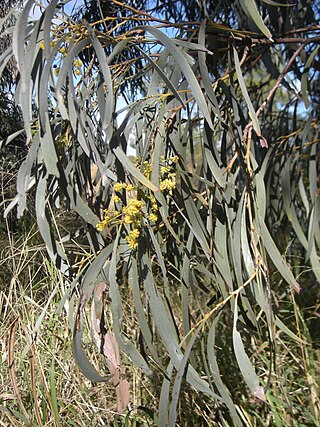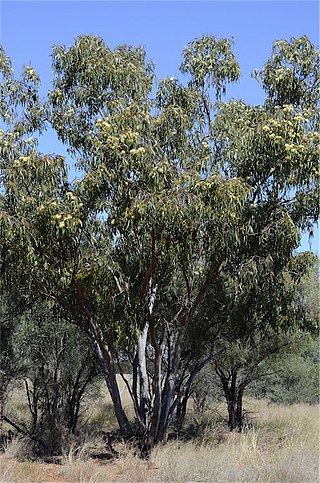Taunton National Park is situated near the town of Dingo approximately 135 km inland from Rockhampton in eastern Central Queensland, Australia. The park encompasses an area of 11,626 ha within the Northern Brigalow Belt bioregion of Queensland; a region widely recognised to contain considerable biodiversity.

Eucalyptus coolabah, commonly known as coolibah or coolabah, is a species of tree found in eastern inland Australia. It has rough bark on part or all of the trunk, smooth powdery cream to pink bark above, lance-shaped to curved adult leaves, flower buds in groups of seven and hemispherical or conical fruit.

Acacia harpophylla, commonly known as brigalow, brigalow spearwood or orkor, is an endemic tree of Australia. The Aboriginal Australian group the Gamilaraay peoples know the tree as Barranbaa or Burrii. It is found in central and coastal Queensland to northern New South Wales. It can reach up to 25 m (82 ft) tall and forms extensive open-forest communities on clay soils.
Wild orange is a common name for several plants bearing fruit reminiscent of oranges. They are not necessarily related to family Rutaceae. Plants called wild orange include:

Acacia cambagei, commonly known as gidgee, stinking wattle, stinking gidgee in English, or gidjiirr, by transliteration from indigenous languages of north-western NSW, is an endemic tree of Australia. It is found primarily in semiarid and arid Queensland, but extends into the Northern Territory, South Australia and north-western New South Wales. It can reach up to 12 m in height and can form extensive open woodland communities. The leaves, bark, and litter of A. cambagei produce a characteristic odour, vaguely reminiscent of boiled cabbage, gas or sewage that accounts for the common name of "stinking gidgee".

Capparis is a genus of flowering plants in the family Capparaceae. It includes 142 species of shrubs or lianas which are collectively known as caper shrubs or caperbushes. Capparis species occur over a wide range of habitat in the subtropical and tropical regions of Africa, Eurasia, Australasia, and the Pacific.

The Brigalow Belt is a wide band of acacia-wooded grassland that runs between tropical rainforest of the coast and the semi-arid interior of Queensland and northern New South Wales, Australia. The Interim Biogeographic Regionalisation for Australia (IBRA) divides the Brigalow Belt into two IBRA regions, or bioregions, Brigalow Belt North (BBN) and Brigalow Belt South (BBS). The North and South Brigalow Belt are two of the 85 bioregions across Australia and the 15 bioregions in Queensland. Together they form most of the Brigalow tropical savanna ecoregion.

Elaeocarpus bancroftii, commonly known as Kuranda quandong, Johnstone River almond, ebony heart, grey nut, or nut tree is a large rainforest tree in the family Elaeocarpaceae which is endemic to Queensland. It has coriaceous leaves, attractive white flowers and relatively large fruit containing an edible kernel.

Amyema quandang is a species of hemi-parasitic shrub which is widespread throughout the mainland of Australia, especially arid inland regions, sometimes referred to as the grey mistletoe.

Capparis fascicularis, the zigzag caper-bush, is a plant in the Capparaceae family and is native to Africa.

Eucalyptus cambageana, commonly known as the Dawson River blackbutt, Dawson gum or Coowarra box, is a species of tree that is endemic to Queensland, Australia. It is a medium-sized tree with hard, rough bark on the lower trunk, smooth white to cream-coloured bark above, lance-shaped or curved adult leaves, flower buds in groups of seven, white flowers and cup-shaped to funnel-shaped fruit.

Ptilotus nobilis, commonly known as yellow tails, is an annual or short-lived perennial herb of the family Amaranthaceae. It is found in arid regions of South Australia, southern and eastern Northern Territory, western Queensland and western New South Wales.

Casuarina cristata, commonly known as belah or muurrgu, is a species of flowering plant in the family Casuarinaceae and is endemic to inland eastern Australia. It is a tree with fissured or scaly bark, sometimes drooping branchlets, the leaves reduced to scales in whorls of 8 to 12, the fruit 13–18 mm (0.51–0.71 in) long containing winged seeds (samaras) 6.0–10.5 mm (0.24–0.41 in) long.

Eucalyptus ochrophloia, commonly known as the yapunyah, is a species of eucalypt native to inland New South Wales and Queensland in eastern Australia.

Acacia argyrodendron, known colloquially as black gidyea or blackwood, is a species of Acacia native to Australia. Czech botanist Karel Domin described this species in 1926 and it still bears its original name. Domin reported collecting the type specimen from somewhere between Camooweal and Burketown in northwestern Queensland, though it is more likely to have been northeast of Aramac.

Eucalyptus bancroftii, commonly known as Bancroft's red gum or orange gum, is a species of tree that is endemic to eastern Australia. It has smooth bark, lance-shaped or curved adult leaves, flower buds usually arranged in groups of seven, white flowers and cup-shaped, conical or hemispherical fruit.

Denhamia oleaster is a shrub or small tree within the family Celastraceae, endemic to Queensland. The species inhabits a variety of environments, from monsoon forest to semi-arid savanna and occurs on a broad range of soil types. In more humid locales the species can grow to 6 metres in height, although it may not reach more than 1 metre in less favourable environments.

Lysiana exocarpi, commonly known as harlequin mistletoe, is a species of hemiparasitic shrub, endemic to Australia. It is in the Gondwanan family Loranthaceae and is probably the most derived genus of that family with 12 pairs of chromosomes. The Loranthaceae is the most diverse family in the mistletoe group with over 900 species worldwide and including the best known species in Australia. Mistletoes are notable for their relationships with other species. In an early reference to the group in Australia Allan Cunningham explorer and first Director of the Royal Botanic Gardens, Sydney, wrote in 1817: "The Bastard Box is frequently much encumbered with the twining adhering Loranthus aurantiacus which 'Scorning the soil, aloft she springs, Shakes her red plumes and claps her golden wings'."
The Weeping Myall Woodlands is an endangered ecological community, under the EPBC Act of the Commonwealth of Australia. It is found in inland Queensland and inland New South Wales, on alluvial plains west of the Great Dividing Range. It takes its name from Acacia pendula, the weeping myall.


















